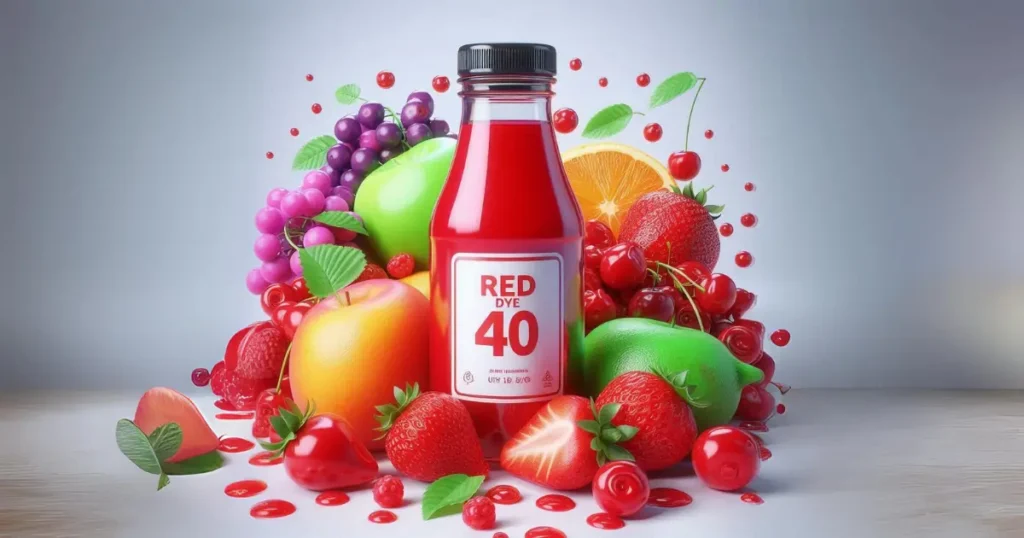
Red Dye 40 is one of the most popular and controversial food colors. The dye may cause allergies, migraines, and mental issues in youngsters. This page will tell you everything you need to know about Red Dye 40, including what it is, its potential adverse effects, and which foods and beverages include it.
Red Dye 40 and color additive
Red Dye 40, a synthetic color additive or food dye derived from petroleum, has received approval from the Food and Drug Administration (FDA) as one of the nine color additives for use in foods and beverages. The European Union has given its approval for its use.
The FDA requires certified color additives to undergo the certification process for every new batch to ensure compliance with legal requirements. Exempt color additives, sourced from natural sources such as fruits, vegetables, herbs, minerals, and insects, do not need batch certification but must still obtain FDA approval before use in foods or beverages.
Is red dye 40 safe?
In addition, both the Food and Agriculture Organization and the World Health Organization have reached a consensus that the estimated dietary exposure to Red Dye 40 poses no health risks for individuals of all age groups. Red Dye 40 has an acceptable daily intake (ADI) of 3.2 mg per pound (7 mg per kg) of body weight, equivalent to 476 mg for a person weighing 150 pounds (68 kg).
The ADI approximates the amount of a substance in food that one can safely consume daily throughout their lifetime without experiencing any negative health impacts.
Research indicates that the average daily consumption of red dye among Americans aged 2 and above is 0.002 mg per pound (0.004 mg per kg) of body weight. Furthermore, another study suggests that Americans may be consuming higher amounts of Red Dye 40, with individuals aged 2 years and older ingesting an average of 0.045 mg per pound (0.1 mg per kg) of body weight daily.
Allergies and migraines
Some people have raised concerns about the safety of Red Dye 40, as it is believed to be a potential cause of allergies and migraines.
Allergies occur when the body’s immune system reacts to a substance that does not typically cause a reaction in most individuals. These substances, known as allergens, can include pollen, dust mites, mold, latex, food, or food components.
Research has suggested a connection between allergic reactions and migraines, which are severe headaches characterized by intense, pulsating pain.
Children and adults have reported allergic reactions to both synthetic and natural food colors, but these reactions are generally rare, mild, and primarily affect the skin.
Behaviors in children
Children diagnosed with ADHD often struggle with maintaining focus, exhibit impulsive behavior, and have difficulty controlling their emotions.
The Food and Drug Administration recognizes that while most children do not display adverse behavioral effects from consuming Red Dye 40, there is some indication that certain children may be more sensitive to it.
Despite some older studies suggesting a link between food dyes and behavioral changes, the majority of evidence does not support this assertion.
How to Identify Red Dye 40
Red Dye 40, one of the most often used color additives, is present in a wide range of foods and beverages, including:
- Dairy items: include flavored milk, yogurt, pudding, ice cream, and popsicles.
- Sweets and baked foods: include cakes, pastries, candies, and chewing gum.
- Breakfast items: such as cereals and bars, as well as jello, fruit snacks, and chips.
- Beverages: soda, sports drinks, energy drinks, and powdered drink mixes, which include some protein powders.
Manufacturers use Red Dye 40, like other color additives, in the production of cosmetics and pharmaceuticals.
By examining the ingredient list, one can pinpoint Red Dye 40. It is also recognized as:
- Red 40
- Red 40 Lake
- FD&C Red No. 40
- FD&C Red No. 40 Aluminum Lake
- Allura Red AC
- CI Food Red 17
- INS No. 129
- E129
Manufacturers are not required to specify the amount of each ingredient used, but they are required to list the ingredients in order of weight, from highest to lowest.
What is Red Dye 40 found in?
Red Dye 40 is a popular ingredient in:
- flavored milk and yogurts
- puddings
- ice cream
- popsicles
- cakes and pastries
- candy and chewing gum
- jello
- breakfast cereals
- soda, sports drinks, and powdered drink mixes
The bottom line
Red Dye 40 is frequently used in: Red Dye 40 is an artificial food coloring derived from petroleum.
Although health organizations generally agree that Red Dye 40 poses minimal health hazards, some studies have linked the dye to allergic reactions and worsened behavior in children with ADHD.
The dye is known by various names and is often present in dairy items, confectionery, snacks, pastries, and drinks.


